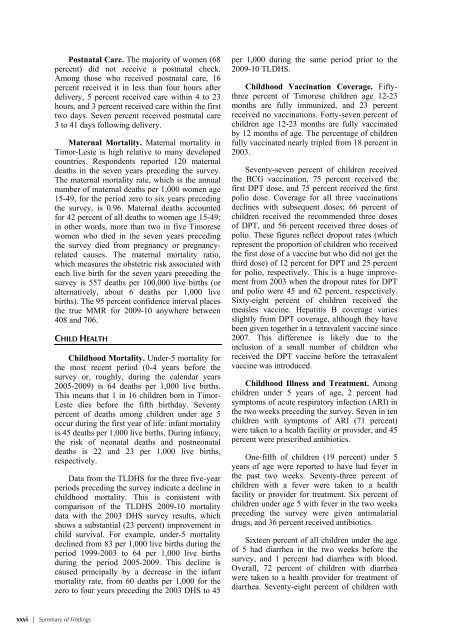Demographic and Health Survey 2009-10 - Timor-Leste Ministry of ...
Demographic and Health Survey 2009-10 - Timor-Leste Ministry of ...
Demographic and Health Survey 2009-10 - Timor-Leste Ministry of ...
You also want an ePaper? Increase the reach of your titles
YUMPU automatically turns print PDFs into web optimized ePapers that Google loves.
Postnatal Care. The majority <strong>of</strong> women (68<br />
percent) did not receive a postnatal check.<br />
Among those who received postnatal care, 16<br />
percent received it in less than four hours after<br />
delivery, 5 percent received care within 4 to 23<br />
hours, <strong>and</strong> 3 percent received care within the first<br />
two days. Seven percent received postnatal care<br />
3 to 41 days following delivery.<br />
Maternal Mortality. Maternal mortality in<br />
<strong>Timor</strong>-<strong>Leste</strong> is high relative to many developed<br />
countries. Respondents reported 120 maternal<br />
deaths in the seven years preceding the survey.<br />
The maternal mortality rate, which is the annual<br />
number <strong>of</strong> maternal deaths per 1,000 women age<br />
15-49, for the period zero to six years preceding<br />
the survey, is 0.96. Maternal deaths accounted<br />
for 42 percent <strong>of</strong> all deaths to women age 15-49;<br />
in other words, more than two in five <strong>Timor</strong>ese<br />
women who died in the seven years preceding<br />
the survey died from pregnancy or pregnancyrelated<br />
causes. The maternal mortality ratio,<br />
which measures the obstetric risk associated with<br />
each live birth for the seven years preceding the<br />
survey is 557 deaths per <strong>10</strong>0,000 live births (or<br />
alternatively, about 6 deaths per 1,000 live<br />
births). The 95 percent confidence interval places<br />
the true MMR for <strong>2009</strong>-<strong>10</strong> anywhere between<br />
408 <strong>and</strong> 706.<br />
CHILD HEALTH<br />
Childhood Mortality. Under-5 mortality for<br />
the most recent period (0-4 years before the<br />
survey or, roughly, during the calendar years<br />
2005-<strong>2009</strong>) is 64 deaths per 1,000 live births.<br />
This means that 1 in 16 children born in <strong>Timor</strong>-<br />
<strong>Leste</strong> dies before the fifth birthday. Seventy<br />
percent <strong>of</strong> deaths among children under age 5<br />
occur during the first year <strong>of</strong> life: infant mortality<br />
is 45 deaths per 1,000 live births. During infancy,<br />
the risk <strong>of</strong> neonatal deaths <strong>and</strong> postneonatal<br />
deaths is 22 <strong>and</strong> 23 per 1,000 live births,<br />
respectively.<br />
Data from the TLDHS for the three five-year<br />
periods preceding the survey indicate a decline in<br />
childhood mortality. This is consistent with<br />
comparison <strong>of</strong> the TLDHS <strong>2009</strong>-<strong>10</strong> mortality<br />
data with the 2003 DHS survey results, which<br />
shows a substantial (23 percent) improvement in<br />
child survival. For example, under-5 mortality<br />
declined from 83 per 1,000 live births during the<br />
period 1999-2003 to 64 per 1,000 live births<br />
during the period 2005-<strong>2009</strong>. This decline is<br />
caused principally by a decrease in the infant<br />
mortality rate, from 60 deaths per 1,000 for the<br />
zero to four years preceding the 2003 DHS to 45<br />
xxvi | Summary <strong>of</strong> Findings<br />
per 1,000 during the same period prior to the<br />
<strong>2009</strong>-<strong>10</strong> TLDHS.<br />
Childhood Vaccination Coverage. Fiftythree<br />
percent <strong>of</strong> <strong>Timor</strong>ese children age 12-23<br />
months are fully immunized, <strong>and</strong> 23 percent<br />
received no vaccinations. Forty-seven percent <strong>of</strong><br />
children age 12-23 months are fully vaccinated<br />
by 12 months <strong>of</strong> age. The percentage <strong>of</strong> children<br />
fully vaccinated nearly tripled from 18 percent in<br />
2003.<br />
Seventy-seven percent <strong>of</strong> children received<br />
the BCG vaccination, 75 percent received the<br />
first DPT dose, <strong>and</strong> 75 percent received the first<br />
polio dose. Coverage for all three vaccinations<br />
declines with subsequent doses; 66 percent <strong>of</strong><br />
children received the recommended three doses<br />
<strong>of</strong> DPT, <strong>and</strong> 56 percent received three doses <strong>of</strong><br />
polio. These figures reflect dropout rates (which<br />
represent the proportion <strong>of</strong> children who received<br />
the first dose <strong>of</strong> a vaccine but who did not get the<br />
third dose) <strong>of</strong> 12 percent for DPT <strong>and</strong> 25 percent<br />
for polio, respectively. This is a huge improvement<br />
from 2003 when the dropout rates for DPT<br />
<strong>and</strong> polio were 45 <strong>and</strong> 62 percent, respectively.<br />
Sixty-eight percent <strong>of</strong> children received the<br />
measles vaccine. Hepatitis B coverage varies<br />
slightly from DPT coverage, although they have<br />
been given together in a tetravalent vaccine since<br />
2007. This difference is likely due to the<br />
inclusion <strong>of</strong> a small number <strong>of</strong> children who<br />
received the DPT vaccine before the tetravalent<br />
vaccine was introduced.<br />
Childhood Illness <strong>and</strong> Treatment. Among<br />
children under 5 years <strong>of</strong> age, 2 percent had<br />
symptoms <strong>of</strong> acute respiratory infection (ARI) in<br />
the two weeks preceding the survey. Seven in ten<br />
children with symptoms <strong>of</strong> ARI (71 percent)<br />
were taken to a health facility or provider, <strong>and</strong> 45<br />
percent were prescribed antibiotics.<br />
One-fifth <strong>of</strong> children (19 percent) under 5<br />
years <strong>of</strong> age were reported to have had fever in<br />
the past two weeks. Seventy-three percent <strong>of</strong><br />
children with a fever were taken to a health<br />
facility or provider for treatment. Six percent <strong>of</strong><br />
children under age 5 with fever in the two weeks<br />
preceding the survey were given antimalarial<br />
drugs, <strong>and</strong> 36 percent received antibiotics.<br />
Sixteen percent <strong>of</strong> all children under the age<br />
<strong>of</strong> 5 had diarrhea in the two weeks before the<br />
survey, <strong>and</strong> 1 percent had diarrhea with blood.<br />
Overall, 72 percent <strong>of</strong> children with diarrhea<br />
were taken to a health provider for treatment <strong>of</strong><br />
diarrhea. Seventy-eight percent <strong>of</strong> children with
















